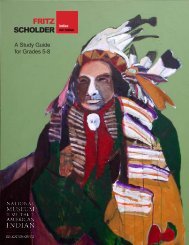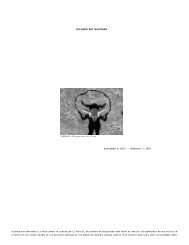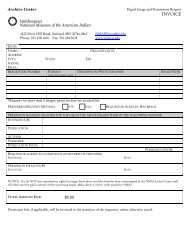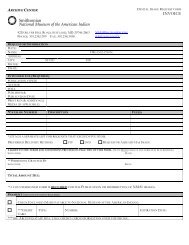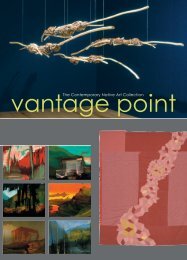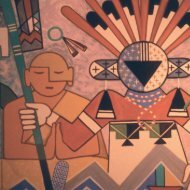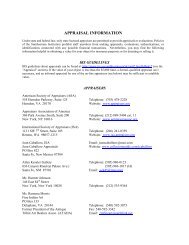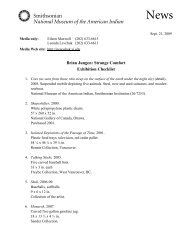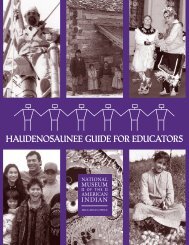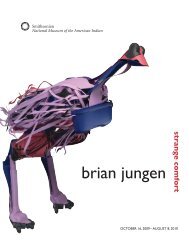Lone Dog's Winter Count - National Museum of the American Indian ...
Lone Dog's Winter Count - National Museum of the American Indian ...
Lone Dog's Winter Count - National Museum of the American Indian ...
Create successful ePaper yourself
Turn your PDF publications into a flip-book with our unique Google optimized e-Paper software.
THE YEAR THE STARS FELL<br />
This astronomical event recorded on <strong>the</strong> <strong>Lone</strong> Dog <strong>Winter</strong> <strong>Count</strong><br />
was seen by people in many parts <strong>of</strong> <strong>the</strong> world in <strong>the</strong> fall <strong>of</strong> 1833.<br />
It is known widely as <strong>the</strong> Leonid Meteor Storm. It was also<br />
recorded on o<strong>the</strong>r Sioux winter counts. The red ovals represent<br />
falling stars, which surround a black crescent moon.<br />
TRADITIONAL SIOUX LANDS<br />
Discussion and Research Questions:<br />
• What states are <strong>the</strong> traditional homelands <strong>of</strong> <strong>the</strong> Sioux? The Nakota?<br />
(Remember that <strong>American</strong> <strong>Indian</strong>s lived in <strong>the</strong>se areas before <strong>the</strong>y<br />
were states)<br />
• What is <strong>the</strong> environment like in <strong>the</strong>se states?<br />
• What are some <strong>of</strong> <strong>the</strong> native animals<br />
in <strong>the</strong>se states?<br />
• What are <strong>the</strong> names <strong>of</strong> some rivers<br />
and lakes in <strong>the</strong>se states?<br />
Map courtesy <strong>of</strong> <strong>National</strong> <strong>Museum</strong> <strong>of</strong> Natural<br />
History and <strong>National</strong> Anthropological Archives,<br />
Lakota <strong>Winter</strong> <strong>Count</strong>s: An Online Exhibit.<br />
http://www.wintercounts.si.edu Based on<br />
Handbook <strong>of</strong> North <strong>American</strong> <strong>Indian</strong>s,<br />
Smithsonian Institution<br />
T EACHING P OSTER<br />
3<br />
REPRODUCIBLE 1<br />
It is a cold clear night on <strong>the</strong> high nor<strong>the</strong>rn<br />
plains in November 1833. A group <strong>of</strong><br />
Yanktonais Nakota have ga<strong>the</strong>red to gaze at <strong>the</strong><br />
night sky. The starlit skies envelop <strong>the</strong> Earth<br />
from horizon to horizon. There are no o<strong>the</strong>r<br />
sources <strong>of</strong> light to interfere, and millions <strong>of</strong> stars<br />
hang brilliantly suspended above <strong>the</strong> ground,<br />
almost touchable. Some are bigger and brighter<br />
than o<strong>the</strong>rs, some glow with warm reddish<br />
tones, o<strong>the</strong>rs pulse vividly white, and some are<br />
<strong>Lone</strong> Dog <strong>Winter</strong> <strong>Count</strong> (detail)<br />
tinted blue and silver. Tonight something very<br />
special is also happening in this sky. Every few minutes a reddish light streaks across <strong>the</strong> sky and fades<br />
into nothing. To <strong>the</strong> Yanktonais, it seems as if <strong>the</strong> stars are falling. The people will observe this celestial<br />
phenomenon throughout much <strong>of</strong> November, and it will serve as a significant event in <strong>the</strong>ir collective<br />
memory and become a part <strong>of</strong> <strong>the</strong> community’s history.



